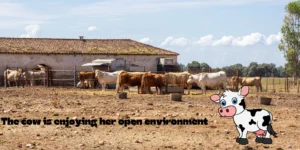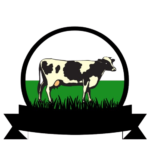
Due to which the cows are happy and
Ensuring the comfort of cows is a top priority for farmers, as happy and healthy cows are more productive and contribute to high-quality dairy and meat products. Farmers implement various strategies, from proper housing and nutrition to healthcare and environmental enrichment, to keep their cows comfortable. This article explores the different ways farmers maintain optimal conditions for their cattle.
1. Providing Comfortable Housing
Cows require well-ventilated, spacious, and clean housing to thrive. Farmers design barns and shelters that cater to the needs of the animals in different weather conditions.
- Adequate Space: Each cow needs sufficient space to move, lie down, and stand up without stress. Overcrowding can lead to competition for food and water and can increase disease transmission.
- Proper Ventilation: Good airflow prevents heat stress in summer and ensures fresh air circulation, reducing respiratory issues.
- Comfortable Bedding: Farmers use materials like sand, straw, rubber mats, or waterbeds to provide soft and clean resting surfaces. Comfortable bedding reduces the risk of joint injuries and infections.
- Temperature Control: In hot weather, farmers install fans, misters, or cooling pads to keep cows cool. In cold weather, barns may have insulation or heating to maintain warmth.
2. Nutritious Diet and Clean Water
 Cows always drink clean water happily
Cows always drink clean water happily
A balanced diet and access to fresh water are essential for cow comfort and overall health.
- Proper Nutrition: Farmers work with nutritionists to create diets that meet the cows’ needs at different life stages. These diets include a mix of hay, silage, grains, minerals, and vitamins.
- Consistent Feeding Schedule: Regular feeding times reduce stress and promote healthy digestion.
- Access to Clean Water: Cows drink large amounts of water daily, so farmers provide clean and easily accessible water sources to keep them hydrated.
3. Health and Veterinary Care
Preventative and responsive veterinary care ensures cows remain in good health.
- Routine Health Checks: Farmers monitor cows for signs of illness or discomfort, such as lameness, infections, or changes in eating habits.
- Vaccinations and Medications: Regular vaccinations prevent diseases, and medications are used when needed under veterinary supervision.
- Hoof Care: Proper hoof trimming prevents lameness and ensures cows can move comfortably.
4. Stress Reduction and Gentle Handling
Minimizing stress in cows improves their overall well-being.
- Gentle Handling Techniques: Farmers use low-stress handling methods, such as calm voices, slow movements, and non-threatening body language.
- Comfortable Milking Process: Modern milking parlors are designed to ensure cows are milked comfortably and efficiently. Some farms even use robotic milking systems that allow cows to be milked at their own pace.
- Avoiding Loud Noises and Sudden Movements: Loud environments can stress cows, so farmers keep their surroundings calm and predictable.
5. Pasture Access and Exercise
Cows benefit from outdoor access, which allows them to graze, move freely, and engage in natural behaviors.
- Rotational Grazing: Farmers move cows between different pastures to ensure fresh grass and reduce overgrazing.
- Shaded Areas: Providing trees, shelters, or artificial shade protects cows from extreme sun exposure.
- Safe Fencing: Secure fencing ensures cows do not wander into unsafe areas while allowing freedom of movement.
6. Environmental Enrichment
Cows thrive when they can engage in natural behaviors and social interactions.
- Social Interaction: Cows are herd animals, so farmers ensure they have companionship to reduce loneliness and stress.
- Scratching Posts and Brushes: Some farms install mechanical brushes that cows can use to scratch themselves, promoting comfort and skin health.
- Music and Calming Sounds: Some farmers play soft music in barns to create a relaxing atmosphere for cows.
7. Cleanliness and Hygiene
A clean environment reduces disease risks and keeps cows comfortable.
- Regular Manure Removal: Farmers use automatic scrapers, flush systems, or manual cleaning to keep barns clean.
- Dry and Clean Bedding: Regular bedding replacement keeps resting areas hygienic.
- Fly and Pest Control: Farmers use natural and mechanical methods to keep flies and pests away from cows.
Conclusion
Farmers use a combination of proper housing, nutrition, healthcare, stress reduction, and environmental enrichment to ensure cows are comfortable. By prioritizing cow well-being, farmers not only improve animal welfare but also enhance productivity and product quality. As farming technology continues to evolve, new innovations will further improve cow comfort and overall farm efficiency.
